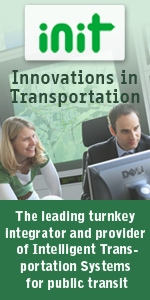

| In This Issue |
| » BREAKING NEWS |
| » NEWS HEADLINES |
| » IN DEPTH: TECHNOLOGY |
| » APTA NEWS |
| » TELLING OUR STORY |
| » COMMENTARY |
| » PEOPLE ON THE MOVE |

Check out the classifieds for numerous transit career opportunities including a chief executive officer!
| IN DEPTH: TECHNOLOGY |
Wireless Broadband Communications Delivering ITS Services for Transit Systems
BY BARRY EINSIG, Market Director, Public Safety and Professional Communications, Harris Corporation, Harrisburg, PA
The need—and benefits—for North American public transit authorities to deploy Intelligent Transportation Systems (ITS) are becoming more and more appealing as the technologies mature.
One major hurdle in the construction of these systems is the transfer of large files or streams, such as video, from a bus or train to the operations center. Providing closed-circuit television (CCTV) video to transit or public safety authorities quickly has proven its value: in the event of an emergency situation, first responders will find no better solution than observing CCTV video streamed in real time over a secure communications network.
Achieving this level of broadband reach and connectivity via an ITS system is a challenge that many transportation agencies have tried to achieve through the purchase of disparate ITS technologies over time. This patchwork approach can cause a number of transmission problems with offloading or backhauling of video and traffic control data from bus, trains, and traffic corridors to operations centers over the wireless network.
Assessing Communications Provider Requirements
Public transportation agencies must consider several elements before selecting a broadband solution, including coverage, cost, capacity, and the provider of the wireless network.
Before deploying a ITS system, transit agencies also need to take into account the available spectrum, technology system integration, operations and maintenance costs, the mission critical nature of the network, and the short-term and long-term business model. Knowing the goals an agency hopes to achieve within the parameters of available resources is imperative to the eventual success of a broadband ITS system.
Private vs. Public
Transportation officials have two options when selecting technologies for their ITS deployments: public networks, offered by carriers such as Verizon, or private networks owned and operated by the agency or municipality.
Agencies that require wireless broadband solutions with low up-front capital costs and can handle the higher long-term operating costs should strongly consider a carrier provider for their broadband communication system.
Transit systems that opt to deploy their own private networks may have higher up-front capital costs, but they can be assured that their ITS system will meet many of their near- and long-term needs—ranging from Computer-Aided Dispatch/Automatic Vehicle Location (CAD/AVL), traffic signal prioritization, and passenger information systems to the most challenging real-time video applications.
An organization wishing to implement the private network option can lower some of the up-front costs if it chooses to share the network with other local government agencies or municipalities. These ITS agencies and their potential partners must work closely together throughout the process to determine the best spectrum, technology, reliability, control, quality of service, service level agreements, and integration strategy for the partnership system. They must also select the right provider to partner within the planning, design, deployment, and maintenance of the systems. These providers include companies in the Land Mobile Radio field, application providers such as CCTV and ITS manufacturers, or a coalition of both.
Other challenges may follow buying a wireless narrowband or broadband network from a local communications contractor or larger generalist systems integrator. This kind of project is not a core competency of a general contractor or systems integrator, which may not offer the technical or service experience needed to deploy these kinds of wide-area networks. Further, such a firm may make decisions on the network based on variable economic or business elements rather than on what is ultimately best for the authority or partnership.
The ideal solution for deploying a wireless narrowband or broadband network for an ITS application or video solution is for the transit agency to rely on the same wireless network providers that it currently uses for its most mission critical networks. By creating an ITS Strategic Plan and working closely with the right technology and service partner well in advance of the procurement, transportation agencies will be in a position to ensure that the deployed system will met their near- and long-term needs—from CAD/AVL and traffic signal prioritization to real-time streaming video.
| « Previous Article | Return to Top | Return to Main | Next Article » |
|
||||||
| AMERICAN PUBLIC TRANSPORTATION ASSOCIATION |
Telephone (202) 496-4800 • Fax (202) 496-4321
Search Back Issues